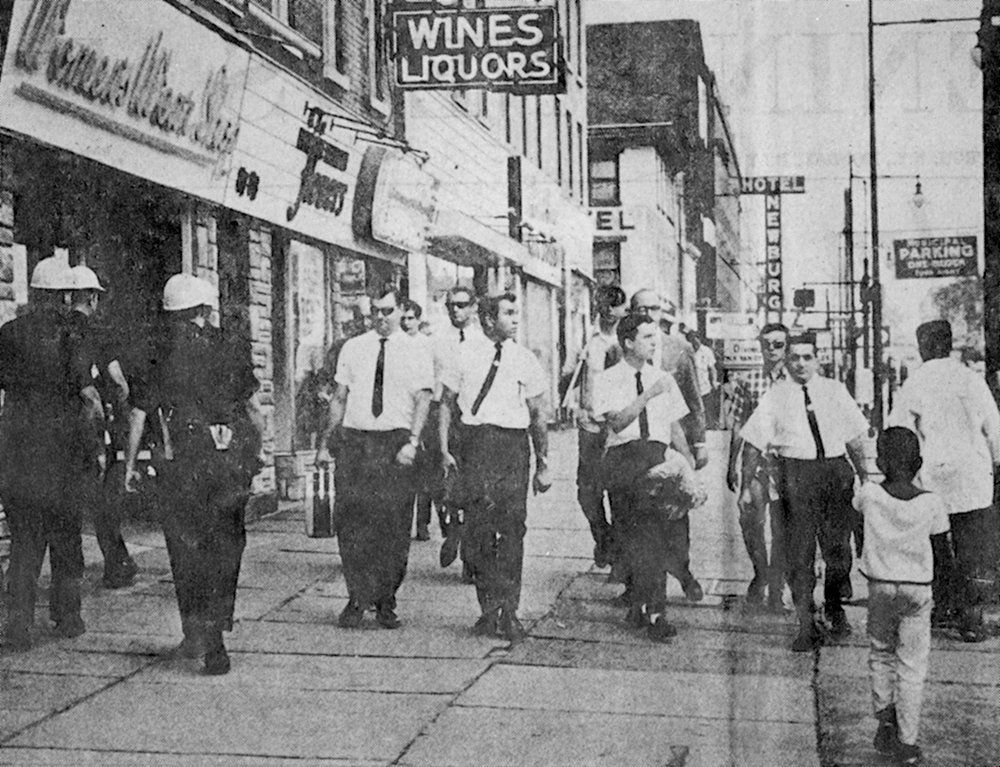
The Orange County chapter of the old National Renaissance Party head into City Hall to get their rally permit, July 29, 1967.
By Mary McTamaney
Eleven men and a boy. That was the tiny force that arrived in Newburgh on the afternoon of Saturday, July 29, 1967 and marched from City Hall to the old county courthouse to hold a meeting. Their actions prompted the first of what has been called the “Newburgh Riots.”
It doesn’t take much to spark anger, fear and disgust. That little band of brothers accomplished their mission. They were the National Renaissance Party, a neo-Nazi group that developed a charter and worked their way up through the courts to gain recognition as a legitimate political party. With that status, they applied for permits to hold rallies and the courts allowed them that right. James Madole was their chairman, a New York City man who had lived over in Beacon. Their regional Orange County chairman was Robert Burros of Newburgh. For lots of reasons, it was Newburgh that the NRP selected as a rally site. They knew a multi-racial city would have a stronger reaction to their march and their message and gain them more press coverage.
The permit they filed asked to use the main courtroom of the county courthouse in the heart of downtown Newburgh. After resisting in several moves, Orange County’s Board of Supervisors finally gave the NRP what they wanted and they booked the courtroom on Grand Street for Saturday evening, July 29, 1967.
History has not chronicled much of what Mr. Burros and Mr. Madole said from the platform of the judge’s bench inside the big courtroom. The NRP faded from history after the death of James Madole and folded in 1981 (not that it wasn’t replaced by other racist groups). Local and regional press did chronicle Newburgh’s reaction to their rally.
The courtroom was packed with spectators as the NRP members entered but, beyond the 125- person capacity of the courtroom, the overflow crowds that came to witness or protest the meeting had been quarantined behind a rope line on Grand Street. Inside, the mostly African-American audience was restless but respectful, asking good questions. Finally, one spectator urged the audience to go and “leave them to talk to the walls” since their answers were so unsatisfying. Most did exit. The meeting broke up around 10 p.m. and the neo-Nazis left to a smattering of jeers. But a young man had stepped up and cut the barricade rope with a knife and, as a crowd surged forward, the police, in a wedge formation, pushed them back. The crowd dispersed to surrounding neighborhoods where some young men started the spate of broken windows and looting that lasted for two hours. It began with a brick through the window of Van’s Grocery Store at First and Lander Street and ended with a tragic fire set at Dom-Rose Clothing Factory at 45 Clark Street.
The next day, Newburgh suffered the second indignity of being a tourist attraction as cars edged through the streets bumper-to-bumper to see the effects of “the riots.”
Newburgh had witnessed hatred and fear and disgust. Children were seen crying in doorways. It suffered broken windows and broken hearts. People yelled at each other and some threw punches and bricks. But many more people spoke with reason and wisdom. The disorder was quickly contained in four hours by police, city officials and by a cadre of community leaders. The NRP didn’t return. The eleven men and the boy went home. They had done their damage.
A thorough chronicle of the 1967 rally can be found in The Evening News special issue of Monday, July 31, 1967. It can be read on microfilm at the Newburgh Free Library when it reopens or articles can be found online at Fultonhistory.com by searching for keywords like NRP Rally and Newburgh.